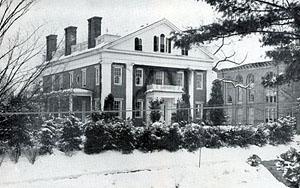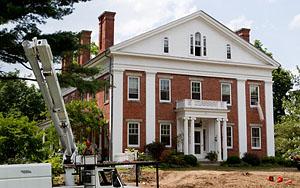AMHERST, Mass. – At 177 years old, the President’s House at Amherst College is undergoing some long-deferred maintenance.
In a stewardship-focused project, the heating, wiring and other systems are being updated as needed. A first-floor restroom will become more handicapped-accessible, and windows are being restored to enhance energy efficiency and insulation.
 |
“The aesthetic appearance of the house will not change,” said James Brassord, director of facilities and associate treasurer at Amherst, who noted that while landscaping changes will be significant, they will also be historically accurate.
The most visible component of the exterior work is the removal of a row of over-mature and diseased hemlock trees in front of the President’s House.
“That row of hedges is being replaced because it has woolly adelgid infestation,” Brassord said. “We also discovered that it couldn’t be pruned without taking out the foliage at the periphery and exposing the brown core of the hedge line.”
A stand of evergreen trees adjacent to the President’s House are also being thinned and pruned, also because of woolly adelgid infestation. Plans call for a hedgerow to be reintroduced, this time with yew, a hardy evergreen that will be maintained to limit its height, Brassord said.
From a historical perspective, the yew will more accurately reflect the original intended purpose of the shrubbery. Indeed, a photograph from 1941 depicts the President’s House fronted by a row of hedges that stand about 3 feet tall.
According to an article that appeared in the college magazine in 1947, the current President’s House was erected in 1834, opposite the “College grounds,” which then consisted of four buildings. (The first President’s House was built in 1821 on the site of the present Seelye House, which was built in 1912.)
 |
Heman Humphrey, the college’s second president, was the first president to occupy the house. The 14,000-square-foot house features a first floor that has been used for official college functions over the years and a second floor that has served as personal living space for presidents and their families.
Planning for the renovations began last fall, so that repairs to the house could be conducted in the brief period when the house is unoccupied.
“There will be no essential or functional changes to the house,” Brassord added. “This project is all about preserving what we have so it can serve future presidents as well as it has served past presidents.”